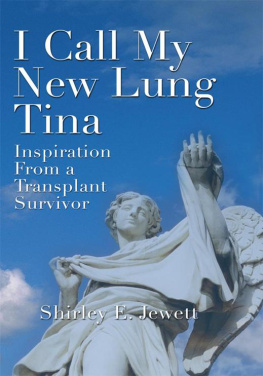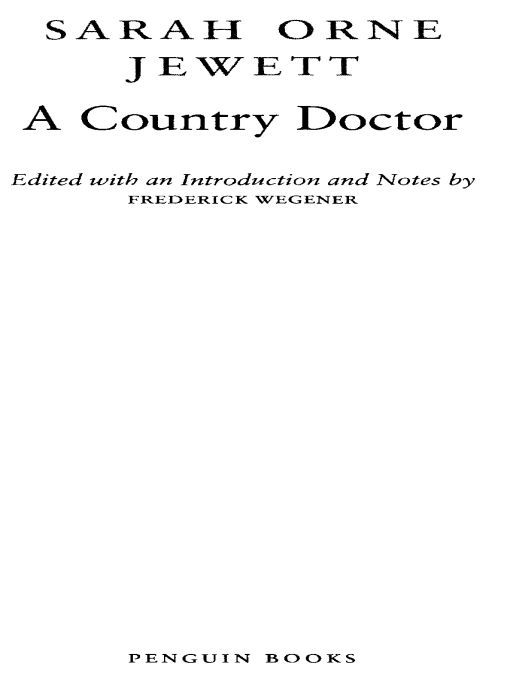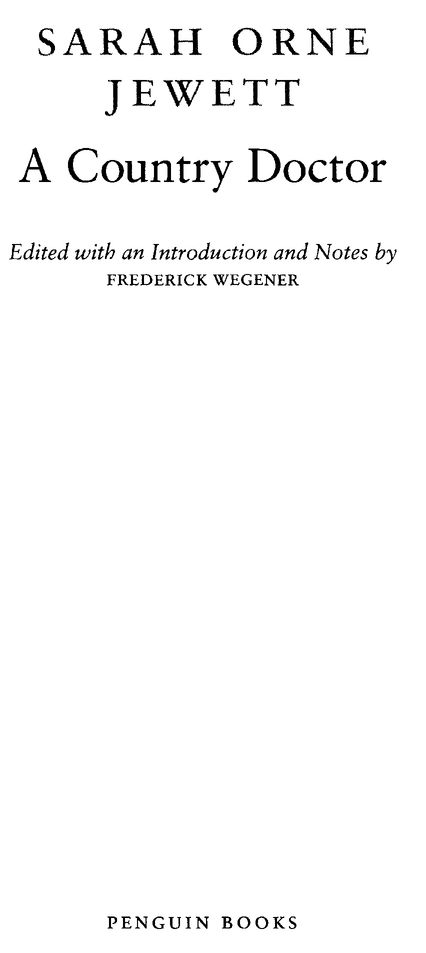Table of Contents
A COUNTRY DOCTOR
SARAH ORNE JEWETT was born in 1849 into a middle-class family in South Berwick, Maine. Her father was a local physician. She graduated from Berwick Academy in 1865 and began writing seriously. Her first story appeared in 1868 in the Atlantic Monthly, which continued to publish her work, as did Harpers, Scribners, and others. She became part of Bostons cultural elite and was good friends with her publisher James T. Fields and his wife, Annie Adams Fields. After his death in 1881, Jewett moved in with Annie, spending part of the year with her in Boston or on the Massachusetts coast and often traveling with her. Jewetts works include Deephaven (1877), A Country Doctor (1884), The Country of the Pointed Firs (1896), and nine volumes of short stories published between 1879 and 1899. She incurred serious injuries in 1902 after being thrown from a carriage and had to give up writing. She died in 1909.
FREDERICK WEGENER is an associate professor of English at California State University, Long Beach, and the editor of Edith Wharton: The Uncollected Critical Writings. His essays have appeared in American Literature, Texas Studies in Literature and Language, Tulsa Studies in Womens Literature, and other journals. He is working on a study of representations of medical women in the United States between 1860 and 1920.
Introduction
In 1882, reflecting upon the status of women in the medical profession in the North American Review, the distinguished physician Mary Putnam Jacobi saw reason for hope and encouragement despite what she called the peculiar bitterness of the opposition which has been manifested to the admission of women to medicine. As evidence that the once continuous opposition has become intermittent, Jacobi pointed to the fact that women are members of various medical societies, contribute to various medical journals, conduct hospitals, perform surgical operations, build up practice, and in other ways seem to conduct themselves and to be treated like other members of the medical profession. Jacobi could have cited her own career as a measure of the progress that women doctors had started to enjoy in the United States. An 1864 graduate of the path-breaking Womans Medical College of Pennsylvania, she had continued her education in Pariswhere she attended clinics, received high honors as the first female enrollee at the cole de Mdecine, and briefly served as a hospital surgeon in the Communebefore returning home to join the faculty of the Womans Medical College of the New York Infirmary for Women and Children, start a successful practice, and become one of the most prolific and scientifically informed medical writers of the day. Few at the time could have provided a more authoritative view than Jacobi of recent improvements in the woman doctors fortunes in the United States: That considerable numbers of women do now study medicine and support themselves by its practice, is itself a proof that the prejudice of thirty years ago has somewhat abated.
In the time since the legendary Elizabeth Blackwell became the first member of her sex to receive a medical diploma in the United States in 1849, American women had indeed made great strides in the field of medicine, in the face of entrenched and often venomous hostility on the part of the medical establishment and much of the public. As of 1880, the nations women physicians already totaled around two thousand (nearly quadrupling the number of a decade earlier) and would increase more than threefold by the second decade of the next century, when the rate at which women attended medical schools entered a steep decline that would not be significantly reversed until the 1970s. And, as their presence became more and more conspicuous, women physicians came to have an impact that reverberated well beyond their own domain, making them the object of an increasingly widespread fascination in the United States in the last third of the nineteenth century. Starting in the 1860s, for example, images of women as doctors began to circulate in works of fiction and verse, steadily accumulating into a wealth of representations that sharpened the vociferous debate under way, in both the medical and mainstream press, about one of the eras more polarizing social phenomena.
The emergence of medical women had already generated abundant imaginative response by the time Sarah Orne Jewett wrote A Country Doctor (1884), completing a trio of American novels about women physicians published in the space of only a few years. Preceded by Dr. Breens Practice (1881), in which William Dean Howells portrays a young woman convinced of her inadequacy as a physician not long after graduating from medical school, and by Elizabeth Stuart Phelpss Doctor Zay (1882), which covers a year in the life of a flourishing rural female practitioner, Jewetts novel offered a third setting forth, as one critic put it, of the doubts and difficulties which beset a young woman who attempts the practice of medicine. Reviewers accordingly grouped A Country Doctor with the earlier two works in pondering [t]he fact that such writers as Mr. Howells, Miss Phelps, and Miss Jewett should within four years so carefully study what is practically the same subject, a coincidence that amply confirmed the medical womans noteworthiness in the United States at the time.
Yet, apart from being set in New England (a region that indeed boasted the nations largest percentage of medical women toward the end of the nineteenth century), the three novels have little in common as incarnations of the woman doctor, a figure Jewett approaches in a particularly distinctive way. Charting the maturation of an orphan adopted by the local physician of a southern Maine village, a middle-aged widower who allows her the freedom to develop unhindered and whom she reverently follows into a medical career, A Country Doctor represents a signal advance in the imaging of women in American medicine, as well as a defining moment in its authors own output. Eclipsed for decades after her death, the novel has undergone an extensive and illuminating critical reevaluation with the enlargement of the American literary canon that began in the 1970s thanks to the rediscovery of so many works by women. Now the most widely studied and discussed of Jewetts works after A White Heron (1886) and The Country of the Pointed Firs (1896), A Country Doctor remains nonetheless an insufficiently understood or appreciated text, more complex and provocatively forward-looking than even the growing body of scholarship on the novel might suggest.
Published in 1884, but covering a period of time that ranges from around the early 1850s through the early 1870S, A Country Doctor evinces a sharp awareness on Jewetts part of the growing salience of medical women and of the developments observed so incisively by Jacobi in the North American Review a couple of years earlier. Although Nan Prince, Jewetts protagonist, is said to have found little encouragement [from] the interest of society in general as she prepares to depart for medical school (where she will receive a degree that was only a formal seal of disapproval in most persons eyes), it is when she ... remembered what renown some women physicians had won that Nan feels emboldened once more to press ahead with her plans. The existence of such inspiring models cannot be denied even by those most bitterly opposed to her choice of a career, one of whom is later forced to acknowledge, Of course I know that there have been some women physicians who have attained eminence.... If, in Jewetts own words, [a]ffairs must rise to a certain level before a narration of some great crisis is suggested, then the controversy ignited by the womens medical movement in the United States had already reached a stage critical enough to call forth the telling of a story like Nans. At the same time, however, a set of far more private circumstances closely affected Jewetts work on







